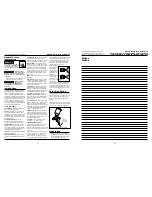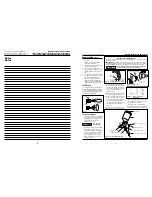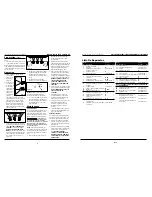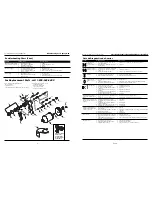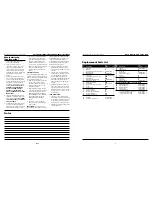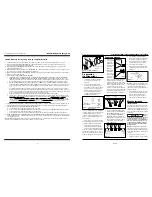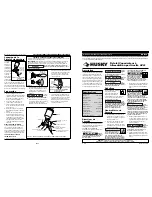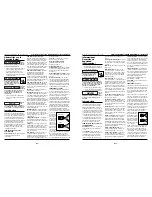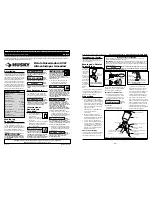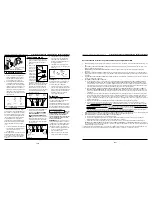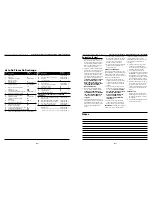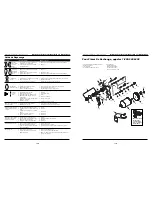
2
Operating Instructions and Parts Manual
HVLP Gravity Feed Spray Gun
General Safety
Information
Do not use pressure that
exceeds the operating pres-
sure of any of the parts
(hoses, fittings, etc.) in the painting
system.
Keep hose away
from sharp objects.
Bursting air hoses may cause injury.
Examine air hoses regularly and replace
if damaged.
7. Always use a pressure regulator on
the air supply to the spray gun.
Failure to install
appropriate
water/oil removal equipment may
result in damage to machinery or
workpiece.
Introduction
The spray gun is a vital link in any fin-
ishing application. In addition to oper-
ating the spray gun properly, tech-
niques of surface preparation and paint
preparation must be understood. These
instructions will explain the differences
among various spray technologies and
serve as a guide in the proper opera-
tion and techniques of spray painting.
Refer to the Replacement Parts Manual
for model specific information.
SPRAY GUN TERMS
Atomization -
Conversion of bulk liq-
uid to spray droplets (mist).
Bleeder –
In this mode, air passes con-
tinuously through the gun whether
spraying or not. This mode is generally
used when the air is supplied by a con-
tinuously running compressor that does
not have a tank.
Bleeder/Non-Bleeder –
Indicates
whether air flows through the gun con-
tinuously or as the trigger is pulled.
External Mix –
Process where the air
and paint are mixed just after leaving
the nozzle. This type of mix should be
used for fast drying paints and when a
high quality finish is needed.
Feed –
Method used to bring paint into
the gun for spraying.
Fluid Control Knob –
Used to control
the amount of paint being mixed with
air.
NOTICE
!
CAUTION
!
WARNING
Gravity Feed –
Method of paint feed
similar to the siphon feed method.
However, the cup is inverted to create a
positive fluid pressure at the nozzle.
Internal Mix –
Process where the air
and paint are mixed inside the air cap
just before being sprayed. This method
is best for heavy bodied, slow drying
paints and can only be used with the
pressure feed method. Do not use fast
drying paints with internal mix. The
paint will dry inside and quickly clog
the air cap.
Mix –
The mixing of paint and air when
spraying.
Non-Bleeder –
In this mode, air flows
only when the trigger is pulled. This
type of operation is used with a com-
pressor equipped with a tank or with a
large factory air system.
Paint Tank –
An auxiliary pressurized
paint reservoir that allows continuous
spraying of large amounts of paint with-
out stopping for refills as with a canister. It
also allows using the spray gun at any
angle without causing paint to drip.
Pattern Control Knob –
Used to form
the proper pattern (size and shape) of
paint as it is sprayed from the gun to
the workpiece.
Pressure Feed –
Method of paint feed
where a canister or paint tank is pressur-
ized to force paint to the gun. Either
internal or external mix air caps are used
with this method. Pressure feed is gener-
ally used for spraying heavy bodied
paints or for large size projects.
Siphon Feed –
Method of paint feed
where atmospheric pressure creates a
partial vacuum to siphon paint to the
gun. Only external mix air caps are used
with this method. Siphon feed is used
with light bodied paints.
Viscosity –
A measurement of the
resistance to the flow of liquids.
CONVENTIONAL VS. HVLP
Conventional spray guns use a much
higher air cap pressure to atomize
paint than HVLP spray guns. This results
in more overspray and a lower transfer
efficiency.
HVLP, electrostatic and airless processes
are currently the only compliant spray
methods that meet the strict 65%
transfer efficiency criteria required by
some air quality management districts.
This enhanced transfer efficiency results
in a significant material savings com-
pared to conventional spraying. Check
local, state and national regulations
that may be in effect before perform-
ing any spraying operations.
HVLP spraying is a
growing trend in
the finishing
industry due to its
environmental
friendliness. By
definition,
dynamic air pres-
sures in the air
cap must be 10
psi or less to qual-
ify as HVLP. A
soft, low velocity pattern is produced
which increases control and reduces
bounceback and overspray (See Figure
1). For these reasons, HVLP is also well
suited for spraying parts with recessed
areas.
Spray Gun Set-up
The pressure for atomization is con-
trolled at the air source. The amount of
fluid is adjusted by the fluid control
knob, the paint viscosity and the air
pressure.
The gravity feed cup screws onto the top
of the gun body creating a positive fluid
pressure in the nozzle (See Figure 2).
Preparation
1. Thoroughly mix and thin paint in
accordance with the paint manufac-
turer’s instructions. Most materials
will spray readily if thinned
Figure 1
Conventional
HVLP
Figure 2 - Gravity Feed Cup Set-up
Filtered,
Regulated
Air Source
27
Notes
Notas
Operating Instructions and Parts Manual
Instructions d’Utilisation et Manual de Pièces
Manual de Instrucciones y Lista de Piezas
HVLP Gravity Feed Spray Gun
Pistolet Vaporisateur à Alimentation par Gravité HVLP
Pistola Pulverizadora HVLP Alimentada por Gravedad


